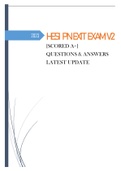Exam (elaborations)
BASIC NURSING ESSENTIALS FOR PRACTICE 7TH EDITION BY POTTER - TEST BANK
- Module
- Nursing Test Bank
- Institution
- Nursing Test Bank
Potter: Basic Nursing, 7th Edition Chapter 03: Community-Based Nursing Practice Test Bank MULTIPLE CHOICE 1. A student nurse is beginning her community health rotation. She anticipates that her assignment in community-based health care will most likely be at which of the following orga...
[Show more]












